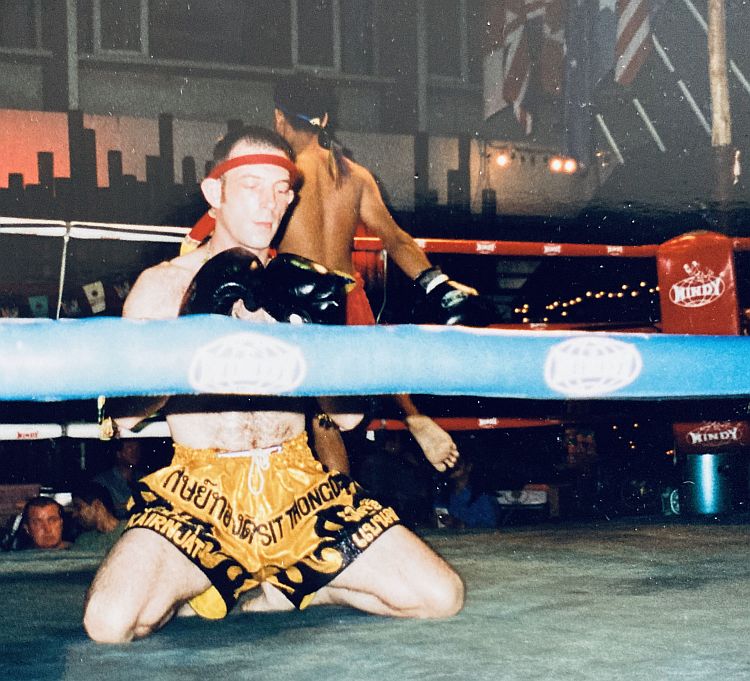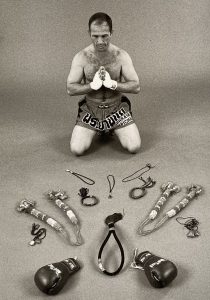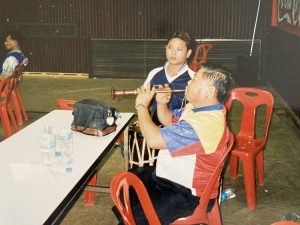
Ritual plays a significant factor in the daily life of every Thai. From the everyday rituals of honouring the house spirits to the more elaborate public displays expressed in the Water Festival ritual is woven into the very fabric of Thai society. Without going into too much detail, I shall attempt to explain the significance of ritual and the part it plays in the practice of Muay Thai.
Thailand, a predominately Buddhist country, follows traditional Buddhist practiced mixed with the pre-Buddhist influences of animism that existed in Thailand since the dawn of prehistory.
Long before the arrival of Buddhism the Thais believed in the cult of spirits and that everything owed its existence to the spirit of that object. They believed (and many still do) that every home has its guardian spirit and is not unusual to see spirit houses in every home in Thailand. In appearance this looks like an altar of some kind, usually elaborate and often decked in flowers, garlands, incense, candles, food and other religious items. These have been placed there by the homeowner in order to keep the spirits happy.
Festivals play a big part in the life of the Thai and are held throughout the year and are practiced fervently, all having immense significance to the general population.

In most villages, towns and cities one can see old men selling amulets and charms to protect the wearer against ‘malevolent spirits’ and the amulets are highly prized amongst collectors and some are worth many thousands of baht (Thai currency). The Thais I have met are very superstitious and place great faith in these objects. I have a few myself and even have one to protect my buffaloes!
In Muay Thai this tradition has continued and it is no surprise to see every Thai Camp with its own spirit house at the entrance and a shrine often inside the gym, although I have heard there are less of these traditions being followed in modern gyms. Obviously this has been as a result of the birth of the tourist gyms that have sprung up all over Thailand in recent times.
Some traditions do continue however, such as the wearing of a Kruang Ruang or Praciet on the upper arm and this is often blessed and serves to give the boxer protection against his opponent. A fighter would never wear the Praciet for dress purposes as it is an object of spiritual importance and should be treated with great respect.
Another type of talisman is the Sak Yant, a tattoo which is believed to confer its owner with great power and confer good luck on the fighter. Some say that a powerful Sak Yant can even prevent one from being cut by swords and knives! One of my students had a Sak Yant to prevent them from being cut with elbows. Not sure it ever worked!
Many of these rituals are handed down from one teacher to the next, and if a young man wishes to fight, he must undergo a ritual of acceptance by a camp and the teacher.
It used to be the case that one couldn’t just simply join a camp! Once a potential boxer has verbal acceptance of a teacher, he must take part in the ritual of Khuen Khru, which is held in front of a Buddhist Shrine flanked on both sides by Thai Boxing equipment. The Boxer will make the usual Buddhist offerings of flowers, incense, a strip of white cloth, candles, money and offerings of food. He will then recite the pledge of loyalty:
“I come here today to pay respect to the teacher and solemnly promise to be truthful in all endeavors. I will treasure all traditions, rules, rituals and techniques that I will learn. I will never harm the reputation of the camp, the teacher or bring his teachings into disrepute. Earth, Heaven and the Four directions bear witness to this pledge. I ask you to help me succeed and ask your blessing forever”
This invocation is followed by a period of meditation and Puja (Buddhist chant). The student is now accepted and is ready to be given his ring name. The teacher will name the boxer according to his physical attributes and aptitude. If for some reason the fighter loses many fights his name will be regarded as inauspicious and will be changed with the help of an astrologer.
Once a fighter is ready to compete, he will be taught the Ram Muay.

Every traditional Muay Thai Camp has its own Ram Muay. The Ram Muay simply translated means “Boxers Dance” and starts outside of the ring. Before entering the ring (but not in all cases) the teacher will place a Mongkon on the fighter’s head. Usually made of hemp, the Mongkon is elaborately decorated and extends over the head and down the back between the shoulder blades, ending in a tassel.
This, the most sacred of all Muay Thai ritual objects, is treated with great reverence and is never placed on the floor and always left hanging on the shrine when not in use. It will have been blessed by the monks and each camp has its own Mongkon, often being passed down from teacher to teacher. The Thais believe that the older the Mongkon, the more powerful its influence over the boxer. Arjarn Tony Moore of the Sitsiam Camp in Manchester has a Mongkon from The Buddhai Sawan Temple that is over 200 years old!
Once placed on the head of the boxer a short chant is spoken over the student and it said that this is to serve as reminder to the boxer that he is not only representing his teacher and camp but his family and Buddhist beliefs.
The fighter will now climb onto the apron of the ring and deliver three bows then climb over the top rope. When wearing the Mongkon a fighter must go over the ropes and never under! It’s considered very bad luck to go through the ropes wearing a Mongkon. He now turns to face his own corner and gives three bows. In Thailand this signifies paying respect to The Buddha, The Dhamma (Teachings) and The Sangha (Community of Monks).
The fighter then moves counterclockwise around the ring, stopping and bowing to each corner. Again, each Ram Muay has its specific rituals and some boxers will simply walk around the ring, effectively sealing it against external influences. This is the first part of the Ram Muay and is always undertaken.
From a western perspective, I find this is a great tool for allowing the fighter to relax and settle their mind. An opportunity to walk around the perimeter of the ring, wiping out all the distractions that can consume a fighter’s mind.
Anyone who has ever fought in a ring will recall those first time nerves. This preliminary ritual, if practiced correctly and with the right cognitive guidance, helps the fighter put things in perspective and take control not only of their mental state but to send a clear message out to the opponent! I use it in conjunction with NLP and hypnosis to help focus and anchor my fighter’s mental state. Maybe I should write a little more on this aspect in a future post!
This ritual complete, the fighter now moves to the middle of the ring and performs his three kneeling bows, paying homage to the teacher, his parents and the camp.
If everything has been done correctly up to this point, the fighter should be in a calm focused state and ready to perform the Ram Muay.
If done well the Ram Muay will be beautiful to watch using as it does sweeping movements of both the arms and legs moving the body toward the four directions in kneeling position.
The number 4 is significant to Buddhists as it represents what is called the Four Noble Truths. One of the core teachings of normative Buddhism teaches that awakening can only happen when we realise that:
- Life is out of balance (Dukkha)
- Craving maintains that state (Dukkha Samudaya)
- We should stop these reactions (Dukkha Niroda) and
- Follow the 8 fold path that leads to Liberation.
I could wax lyrical about the above, but I suggest you check out my other blog for material of that nature: https://fiftyshadesofzen.com
Each camp has its own Ram Muay, and its Ram Muay could readily identify a camp. Originally this was done to prevent fighters from the same teacher fighting each other.
One thing, however, does remain the same throughout and that is the ancient Khune Prone or Brahma Dance of Krabi Krabong.
The Khune Prone emphasize particular movements and remains unchanged in all Ram Muay. This is to ensure that the virtues of compassion, temperance, prudence and justice are extolled to balance the hard external form of the fight that is about to take place.
Whilst performing the Ram Muay the fighter is also demonstrating balance, poise, rhythm and power to his opponent and through psychological techniques will build a powerful mental state preparing him for the fight. It can also serve as a great way to warm up before the fight too!
The boxer is not under pressure to hurry the Ram Muay and it takes as long as it takes to complete. During the whole ritual a band will play a specific melody that is supposed to replicate the steady beat of the heart to keep him calm and focused. It’s usually a three-piece band consisting of small cymbals (Chuig) a Flute-like instrument (Pi) and a Drum (Glaeng Glak)
The ritual finished, the boxer returns to his corner awaiting the instructions of the referee whereupon the teacher blows over the head of the fighter, the Mongkon is removed and placed over the corner post and the fight begins!